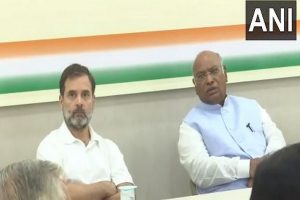Finance Minister Nirmala Sitharaman arrived at the Ministry of Finance ahead of the Union Budget presentation on Tuesday.
The Finance Minister was pictured wearing a white saree with a violet border as she arrived at the Ministry.
Nirmala Sitharaman is set to present the Union Budget 2024 in Parliament today, marking her seventh consecutive budget and eclipsing the late Moraji Desai’s record of six consecutive budgets, which is likely to focus on changes in the income tax structure and improving the ease of doing business in India.
Sitharaman tabled the Economic Survey 2023-24 along with the statistical appendix on Monday.
Minister of State for Finance Pankaj Chaudhary and Chief Economic Advisor V Anantha Nageswaran reached the Ministry earlier.
Speaking to the media, Minister of State for Finance Pankaj Chaudhary said that the first Union Budget of the third Modi government will be based on his mantra of “Sabka Saath Sabka Vikas”.
Sitharaman will lay on the table a statement (in English and Hindi) of the estimated receipts and expenditures of the government for the year 2024-25 in the Rajya Sabha.
With this upcoming budget presentation, Finance Minister Nirmala Sitharaman will surpass the record set by former Prime Minister Morarji Desai, who presented five annual budgets and one interim budget between 1959 and 1964 as finance minister. The budget session of Parliament began on July 22 and, according to schedule, will end on August 12.
On Monday, The economic survey presented in the Parliament by finance minsiter Nirmala Sithraman says in the medium term Indian economy can grow at a rate of 7 per cent.
The economic survey stated, “In the medium term, the Indian economy can grow at a rate of 7 per cent plus on a sustained basis if we build on the structural reforms undertaken over the last decade. This requires a tripartite compact between the Union Government, State Governments and the private sector.”
The survey further added that India faces a unique blend of opportunities and challenges amid global trends such as geo-economic fragmentation, a push for self-reliance, looming climate change, the rise of technology, and limited policy space.
It suggested that the government’s focus must shift to bottom-up reforms and strengthening governance to ensure that the structural reforms of the past decade result in strong, sustainable, balanced, and inclusive growth.
The growth strategy for the medium term, termed “Amrit Kaal,” hinges on six critical areas. First, there must be a deliberate focus on boosting private investment. Second, the growth and expansion of India’s MSMEs (Mittelstand) should be a strategic priority. Third, the potential of agriculture as an engine of future growth must be recognized, with policy impediments removed. Fourth, securing the financing of India’s green transition is essential. Fifth, bridging the education-employment gap is necessary. Finally, focused building of state capacity and capability is required to sustain and accelerate India’s progress.












